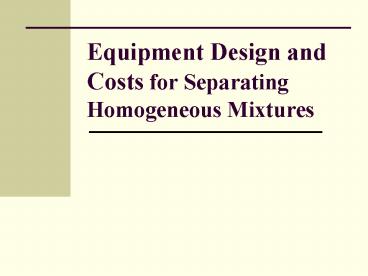Equipment Design and Costs for Separating Homogeneous Mixtures - PowerPoint PPT Presentation
1 / 36
Title:
Equipment Design and Costs for Separating Homogeneous Mixtures
Description:
Equipment Design and Costs for Separating Homogeneous Mixtures Basic Adsorption Cycles Temperature Swing cycle Cycle time: few hours Capacity: 1 kg per 100 kg of ... – PowerPoint PPT presentation
Number of Views:266
Avg rating:3.0/5.0
Title: Equipment Design and Costs for Separating Homogeneous Mixtures
1
Equipment Design and Costs for Separating
Homogeneous Mixtures
2
- 1. Distillation
3
Design Procedures for Columns with Sieve Trays
- Designation of design bases
- Composition and physical properties of feed and
product - Special limitations maximum temperature and
pressure drop restrictions, presence of reactive
materials or toxic components etc - Selection of design variables operating
pressure, reflux ratio, feed condition - Establishment of physical equilibria data
- data for binary pairs are combined with a model
(Wilson, NRTL and UNIQUAC) to predict
multi-component behavior UNIFAC model is used
for prediction based on functional group
4
Design Procedures for Columns with Sieve Trays
(contd)
- Determination of number of equilibrium stages
- Underwood equation for minimum reflux
- Minimum number of stages from Fenske equation
- Number of equilibrium stages, N as a function of
and (Gilliand equation)
5
Design Procedures for Columns with Sieve Trays
(contd)
- Selection of column internals
6
Design Procedures for Columns with Sieve Trays
(contd)
- Determination of column diameter
7
Design Procedures for Columns with Sieve Trays
(contd)
- Efficiency
- Tray Spacing 0.46 to 0.61 m (0.3 and 0.91
m are also used) - Column height
8
Design Procedures for Columns with Sieve Trays
(contd)
- Sieve Tray Geometry
- Hole dia 0.005-0.025 m
- Fractional free area 0.06-0.16 m2
- Fractional downcomer area 0.05-0.3 m2
- Pitch/hole dia ratio 2.5-4.0
- Tray spacing 0.305-0.915 m
- Weir height 0.025-0.075 m
9
Design Procedures for Columns with Random Packing
- Determination of diameter
- Vapor velocity is 70 to 90 of flooding velocity
- Recommended pressure drop
- 400 to 600 Pa/m for atmospheric and high-pressure
separation - 4 to 50 Pa/m for vacuum operations
- 200 to 400 Pa/m for absorption and stripping
column
10
Design Procedures for Columns with Random Packing
(contd)
- Heights of columns
- HTU method
11
Design Procedures for Columns with Random Packing
(contd)
- HETP method
12
Design Procedures for Columns with Structured
Packing
13
Design Procedures for Columns with Structured
Packing (contd)
- Diameter
- Height
- HETP Rule of thumb
14
Other Distillation Processes
- Batch distillation
- Food, pharmaceuticals and biotechnolgy industries
- Rayleigh equation
15
Other Distillation Processes (contd)
- Azeotropic distillation
16
Cost Estimation
17
Cost Estimation (contd)
- Costs of distillation column
25 trays
50 trays
18
Cost Estimation (contd)
- Costs of sieve tray
19
Cost Estimation (contd)
20
Cost Estimation (contd)
21
Cost Estimation (contd)
22
Cost Estimation (contd)
23
- 2. Absorption and Stripping
24
Gas Treatment with Solvent Recovery
25
Design Procedures
- Column diameter 70 to 90 of the flooding
velocity, Larger of the top or bottom diameter is
used - Number of equilibrium stages Modified Kremser
equation
Solute fraction absorbed
Solute fraction stripped
26
Design Procedures (contd)
- Stage efficiency and column height
- Overall efficiency
- Column height Tray spacing/HTU/HETP
27
- 3. Membrane Separation
28
Selection of Membranes
- Fabricated from natural and synthetic polymers
- Membrane modules
- Plate and Frame (250-400/m2)
- Spiral-wound (25-100/m2)
- Hollow fiber (10-20/m2)
- Tubular (250-400/m2)
- Capillary (25-100/m2)
- Ceramic (1000-1600/m2)
29
Concentration Profile across Membranes
30
Design Parameter
- Permeance porosity, solubility or partition
coefficient - Separation factor/selectivity
- Purity and yield
31
Flow Patterns
32
- 4. Adsorption
33
Selection of Adsorbent
- Activated Carbon
- Molecular Sieve Zeolites
- Silica gel
- Activated Alumina
34
Basic Adsorption Cycles
- Temperature Swing cycle
- Cycle time few hours
- Capacity 1 kg per 100 kg
- of adsorbent
35
Basic Adsorption Cycles (contd)
- Inert Purge cycle
- Regeneration is done by purging inert gas and
lowering the partial pressure of the adsorbate - Cycle times are only a few minutes
- Capacity 1 to 2 kg adsorbate per 100 kg adsorbent
36
Basic Adsorption Cycles (contd)
- Pressure Swing cycle
- Cycle time few minutes
- Capacity 1 to 2 kg per
- 100 kg adsorbent































